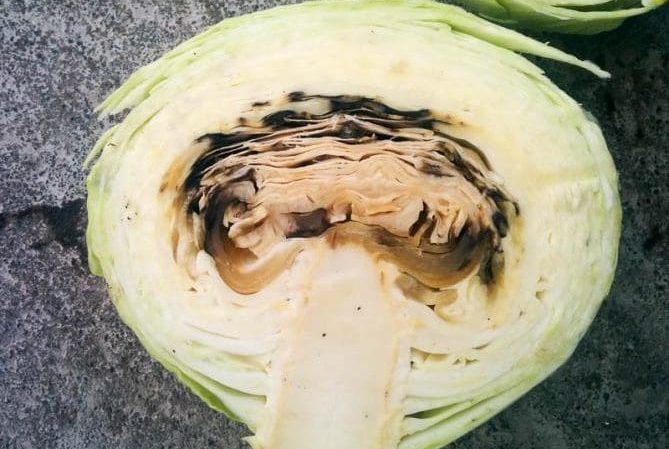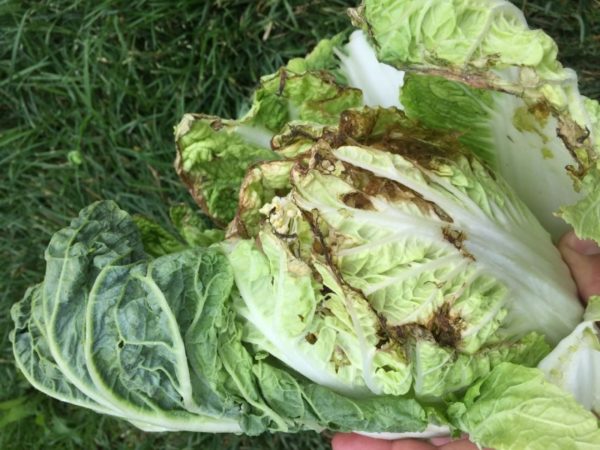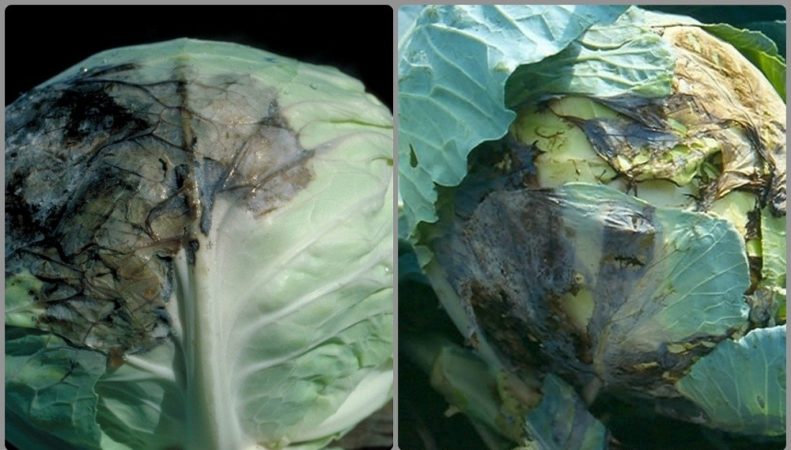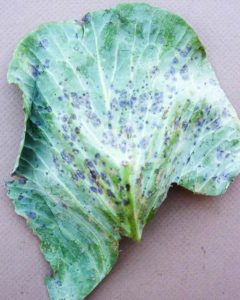Why does cabbage turn black inside?
Gardeners are making every effort to grow a decent harvest of cabbage. But sometimes they encounter a problem - blackening of the leaves inside the head of cabbage. This can happen both in the garden, during the growth of the vegetable, and during its further storage. In this article we will look at why white and Chinese cabbage turn black inside.
Why does cabbage turn black inside the head?
Many people are alarmed by the non-standard appearance of cabbage: dark spots, black dots on the leaf blades. Some cut out these areas and eat the undamaged ones, while others do not buy such a vegetable at all, so as not to harm their health. You need to understand the reasons for the blackening of the leaves, whether you can eat such a vegetable and what to do about it.

White cabbage
Darkening of the inner leaves of white cabbage may be non-infectious in nature. For example, with calcium deficiency, the edges of the leaves darken and become brown or black. Over time, the darkening moves towards the stalk of the head of cabbage and the middle.
There are other reasons why the leaves of a head of cabbage turn black:
- Violation of agricultural technology rules. Thickened or too shaded crop plantings, neglect of the soil loosening procedure, violation of crop rotation, acidic soil, waterlogging of the beds or water getting into the outlet when watering, etc.
- Adverse weather conditions. Prolonged rains, when the soil does not have time to dry out, which causes the lower leaves and even stalks to rot. It is very difficult to preserve the harvest in such weather conditions.The affected leaves are removed so that the entire head of cabbage does not spoil.
- Bacterial or fungal diseases of the crop: gray rot, mucous bacteriosis, white rot, fusarium, etc. Hot weather is considered an indirect cause of rot on cabbage. Under such conditions, pests begin to actively multiply and eat plant leaves, provoking the development of infections. High temperature combined with high humidity often leads to bacterial infection.
Beijing
Inside the head of cabbage Chinese cabbage leaves turn black due to development diseases, which almost all manifest themselves as rot.

Mucous bacteriosis, or wet rot
Signs of infection appear more often in the second half of the growing season. The veins of the leaf turn black, forming a black mesh. The cabbage begins to rot and emit an unpleasant odor. In the head of cabbage, dry, wrinkled, transparent leaves can be seen between the leaves. They fall off, and the rot spreads into the middle of the fork.
The causes of the disease may be:
- injury to the plant during care;
- soil is too wet;
- temperature above +25°C;
- water getting on the leaves when watering;
- caterpillars that penetrate deep into the head of cabbage.
- excess nitrogen and lack of potassium and calcium in the soil.
Vascular bacteriosis, or dry rot
One of the most dangerous and widespread fungal cabbage diseases. It develops especially intensively in warm weather with high air humidity. The disease enters the plant with insects or during rains and can occur at any stage of the plant's growing season.
A characteristic sign is yellowing of the affected leaf, then blackening of the veins, after which the leaves darken completely and die. Sick plants develop poorly and do not set heads.The fungus remains viable in the soil for up to 2 years.
Attention! Even if the plant is slightly damaged by vascular bacteriosis, the harvested heads of cabbage will rot in the basement.
Gray rot
A disease of fungal origin usually appears at the end of summer on those heads of cabbage that have suffered from mechanical stress. Favorable conditions – heavy rains, high humidity. Visually, the fungus appears as a white fluffy coating on the upper leaves of cabbage.
As the disease progresses, an unpleasant odor appears, the rot becomes wetter, as a result of which the leaves become covered with solid mucus. Over time, gray rot penetrates into the inside of the head of cabbage. If damaged areas are not removed in a timely manner, the entire harvest will be lost.
Reasons why cabbage turns dark inside during storage

If basic storage rules are not followed, cabbage loses its beneficial properties and taste over time.
The leaves turn black inside the head and on the cut under the influence of several factors:
- Inspection was not carried out carefully forks before storing. You need to select only clean and healthy specimens without external damage: spots, cracks, deformation of the fruit. The cut on the stalk should be even, smooth, of normal structure and color. The cover sheets are hard, but not dry, tightly adjacent to the fork, rich in color, characteristic of the variety or hybrid.
- Storage conditions were not followed. Insufficient air access, inappropriate temperature conditions, changes in humidity levels. Under such conditions, microorganisms are activated, which destroy the vegetable and make it unsuitable for further consumption. The most suitable temperature for storing the crop is from -1 to 3°C.The cellar must be disinfected.
- Freezing fruits Although cabbage is not afraid of cold weather, temperatures below 0°C negatively affect the keeping quality of heads of cabbage. A layer of ice forms between the outer layers of leaves, which does not allow air to pass through to the middle of the head of cabbage. As a result, favorable conditions are created there for the development of pathogenic microorganisms. When ice melts, moisture forms between the sheet plates, which also contributes to rotting.
- Fusarium wilt. It affects those forks that were formed in dry weather without proper watering. Brown dots of blood vessels will be visible on the cut of the vegetable.
- Alternaria blight. Most often it affects young plants and already harvested crops that are in storage. It develops very rapidly, capturing all the leaves of the head of cabbage, after which they are easily separated from each other.
In most cases, cabbage rots on the vine precisely because of errors in agricultural technology. To grow a good harvest, you need to follow the recommendations for caring for the crop.
Is it possible to eat blackened cabbage?
A change in the appearance of the head of cabbage indicates infection with a fungus that releases toxins dangerous to the body. They can cause serious abnormalities in the functioning of the digestive system: nausea, vomiting, as well as allergic reactions, exacerbation of existing chronic diseases and many other disorders.
If a vegetable is stored in the refrigerator for a long time or incorrectly, it loses its benefits and becomes tasteless. It should not be eaten.
A head of cabbage affected by gray rot can be cleaned. Damaged leaves are broken off or cut with a knife and used for processing.
If there are dark spots on the leaves, gardeners can wash the cabbage well, cut out the damage and then use it for cooking. The taste of the vegetable will remain the same. However, you should not buy a head of cabbage with black marks. It is also better not to eat cabbage with leaves in a hole.
Heads of cabbage affected by mucous bacteriosis cannot be eaten. The disease is indicated by foul-smelling mucus that can be seen on the outer leaves.
Why do cabbage leaves have brown spots inside?

The causes of brown dots are punctate necrosis and Alternaria blight.
With punctate necrosis, brown or black spots appear. They usually appear on the outer leaves, but often reach the inner ones. The size varies from 0.5 mm to 4 mm.
The shape of the black or brown spots is elongated or round. These points appear during the cultivation or storage of crops. If pinpoint necrosis is detected during storage, this indicates damage to at least 40% of the harvested vegetables.
This is a physiological non-infectious plant disease. It occurs when there is a metabolic disorder. The main reason is alkalization of the soil, which occurs when there is an excess of phosphorus and nitrogen. To prevent this phenomenon, the soil is acidified during growth. To do this, add manure or humus to the soil.
Alternaria also appears as brown or black spots. This is a fungal disease. It is especially common in the Krasnodar Territory and coastal areas.
Infection occurs during cabbage growth. The infection spreads to the crop from plant debris, which serves as an incubator for the fungus. To prevent the development of the disease, all remains at once removed from the garden and burn it.It is also important to regularly treat cabbage with special preparations.
Conclusion
Cabbage is a fairly delicate crop that is susceptible to many diseases. Often during storage she turns black inside. To prevent this, follow agrotechnical rules, apply fertilizing, and monitor the acidity of the soil. It is also important to create the correct storage conditions to ensure the safety of the crop.